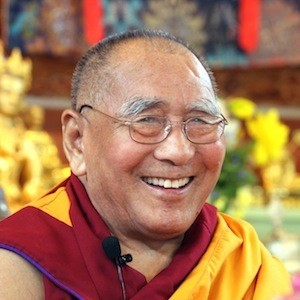
According to traditional meditation lore, they are in a meditative state (thukdam) until their consciousness is clear; only then does the body begins to decay. Neuroscientist Richard J. Davidson. saw it for himself, then organized a study of the phenomenon:
We are told that one of the more remarkable effects of a lifetime of meditation can be a comparatively slow decay process for the body. Recent evidence for that emerged in the death of Tibetan Buddhist monk Geshe Lhundub Sopa, August 28, 2014, at the age of 91.
Geshe Lhundub Sopa (1923-2014) Sopa, who had been tutor to the Dalai Lama in Tibet, moved to Wisconsin in 1967. There he co-founded the Deer Park Buddhist Center and taught South Asian Studies at the University of Wisconsin, becoming a friend of prominent American neuroscientist Richard J. Davidson…
“By conventional Western standards, Sopa died on August 28, 2014. Five days later, and two days after Davidson’s initial visit, the neuroscientist returned to Deer Park and observed his friend’s body a second time. “There was absolutely no change. It was really quite remarkable,” he said. – Daniel Burke, “The Thukdam Project” At Tricycle (July 28, 2021)”
Tibetan Buddists believe that such monks are not dead yet but in a deep, final meditative state called thukdam during which consciousness is gradually transformed into a clear awareness (“clear light”), after which the body begins to decay. After seven days, Sopa’s body started to decay and he was cremated.
News, “Buddhist monks’ bodies decay very slowly at death” at Mind Matters News
Neuroscientist Richard Davidson and colleagues found no evidence of brain activity accompanying the stasis in decay for maybe a week in such monks. We might have expected that but it doesn’t explain why their bodies don’t begin the decay process shortly after death.
Takehome: There is a practical side to this: Buddhists think the Western conception of death is too narrow, saying that death is a process, not an event. What would that do for definitions of death?
Of course, the phenomenon raises questions about the nature of consciousness.
See also: Tibetan monks can change their metabolism. Far from disproving it, science has documented it.For decades, a default assumption would be that claims that meditating monks in the Buddhist tradition could greatly raise their temperature or slow their metabolism were assumed to be exaggerations that would yield to a scientific explanation. The scientific explanation turned out to be that they can do exactly that.
and
Your mind vs. your brain: Ten things to know